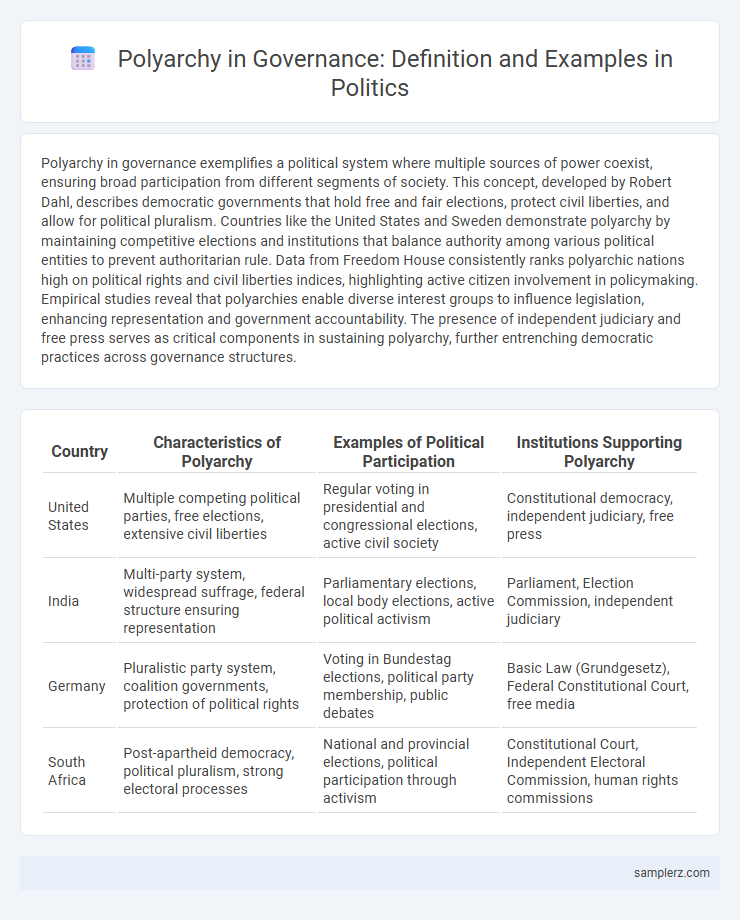Polyarchy in governance exemplifies a political system where multiple sources of power coexist, ensuring broad participation from different segments of society. This concept, developed by Robert Dahl, describes democratic governments that hold free and fair elections, protect civil liberties, and allow for political pluralism. Countries like the United States and Sweden demonstrate polyarchy by maintaining competitive elections and institutions that balance authority among various political entities to prevent authoritarian rule. Data from Freedom House consistently ranks polyarchic nations high on political rights and civil liberties indices, highlighting active citizen involvement in policymaking. Empirical studies reveal that polyarchies enable diverse interest groups to influence legislation, enhancing representation and government accountability. The presence of independent judiciary and free press serves as critical components in sustaining polyarchy, further entrenching democratic practices across governance structures.
Table of Comparison
| Country | Characteristics of Polyarchy | Examples of Political Participation | Institutions Supporting Polyarchy |
|---|---|---|---|
| United States | Multiple competing political parties, free elections, extensive civil liberties | Regular voting in presidential and congressional elections, active civil society | Constitutional democracy, independent judiciary, free press |
| India | Multi-party system, widespread suffrage, federal structure ensuring representation | Parliamentary elections, local body elections, active political activism | Parliament, Election Commission, independent judiciary |
| Germany | Pluralistic party system, coalition governments, protection of political rights | Voting in Bundestag elections, political party membership, public debates | Basic Law (Grundgesetz), Federal Constitutional Court, free media |
| South Africa | Post-apartheid democracy, political pluralism, strong electoral processes | National and provincial elections, political participation through activism | Constitutional Court, Independent Electoral Commission, human rights commissions |
Defining Polyarchy: Core Principles in Governance
Polyarchy is characterized by multiple centers of power, where elected officials hold authority, free and fair elections occur regularly, and citizens have the right to participate in political processes. Core principles include political pluralism, inclusiveness, and contestation, ensuring diverse voices shape governance. Established democracies like the United States and India exemplify polyarchy through institutionalized checks and balances and active political competition.
Historical Emergence of Polyarchy in Political Systems
Polyarchy emerged historically as a form of governance characterized by inclusive participation, competitive elections, and institutionalized constraints on power, exemplified by the evolution of democracy in Western Europe during the 19th and 20th centuries. The transition from autocratic regimes to polyarchic systems was marked by expanded suffrage, the rise of political parties, and strengthened civil liberties, as seen in the United Kingdom's gradual reform acts and the establishment of constitutional monarchies. This model laid the foundation for modern democratic institutions that balance authority with pluralism and political freedom.
Key Features of Polyarchic Government Structures
Polyarchic government structures exhibit key features such as widespread political participation, where multiple interest groups and parties compete freely in elections, ensuring diverse representation. Institutionalized civil liberties, including freedom of speech, assembly, and press, protect individuals' rights to influence governance. Furthermore, polyarchies maintain rule of law and transparent decision-making mechanisms, fostering accountability and limiting authoritarian domination.
Polyarchy versus Other Democratic Models
Polyarchy exemplifies a form of governance characterized by multiple, competing centers of power, emphasizing inclusiveness and public contestation. Unlike direct democracy, which relies on direct citizen participation, polyarchy operates through representative institutions and pluralistic competition. This model contrasts with authoritarian regimes by sustaining regular, free elections and civil liberties, highlighting a distinct balance between political participation and institutional constraints.
Classic Examples: Polyarchy in Scandinavian Countries
Scandinavian countries such as Sweden, Norway, and Denmark exemplify polyarchy through their robust democratic institutions, broad political participation, and protection of civil liberties. These nations feature multi-party systems, proportional representation, and active citizen engagement, ensuring power is distributed across diverse groups. Their governance models emphasize transparency, accountability, and inclusive policymaking, reflecting key attributes of polyarchic systems.
Polyarchy in Contemporary European Governance
Polyarchy in contemporary European governance is exemplified by the European Union's institutional framework, which balances power among multiple elected bodies such as the European Parliament, the Council of the European Union, and the European Commission. This polyarchic system promotes pluralism by enabling diverse political parties, interest groups, and member states to participate in decision-making processes. Mechanisms like multilingual debates, proportional representation, and judicial oversight ensure inclusive governance and protect democratic values within the EU.
The United States: A Case Study of Polyarchic Elements
The United States exemplifies polyarchy through its decentralized political system featuring competitive elections, multiple political parties, and institutional checks and balances. Power is distributed across federal, state, and local governments, enabling pluralistic participation and preventing authoritarian control. Civil liberties such as freedom of speech and association further support the polyarchic framework by fostering diverse political expression and accountability.
Latin American Polyarchies: Progress and Challenges
Latin American polyarchies exhibit a complex blend of democratic institutions and persistent challenges, where countries like Brazil and Chile have made significant strides in electoral transparency and civil liberties. Despite advancements in political pluralism and citizen participation, issues such as corruption, economic inequality, and institutional instability continue to hinder full democratic consolidation. Efforts to strengthen rule of law and enhance accountability mechanisms remain critical for advancing polyarchic governance in the region.
Impact of Polyarchy on Political Participation and Pluralism
Polyarchy, characterized by multiple centers of political power and electoral competition, enhances political participation by providing citizens with diverse channels for engagement and influence. This governance model fosters pluralism by accommodating various interest groups, enabling representation of minority views, and preventing dominance by a single party or faction. Empirical studies demonstrate that polyarchic systems correlate with higher voter turnout, increased civil liberties, and stronger institutional checks and balances that promote democratic resilience.
Future Prospects for Polyarchic Governance Worldwide
Polyarchy, characterized by inclusive participation and competitive elections, continues to expand as nations adopt democratic institutions and protect civil liberties. Emerging trends highlight increased digital engagement and decentralized decision-making, enhancing transparency and accountability in governance. Future prospects suggest that polyarchic systems will evolve with technological advancements and global interconnectedness, promoting more responsive and resilient political frameworks.

example of polyarchy in governance Infographic
 samplerz.com
samplerz.com